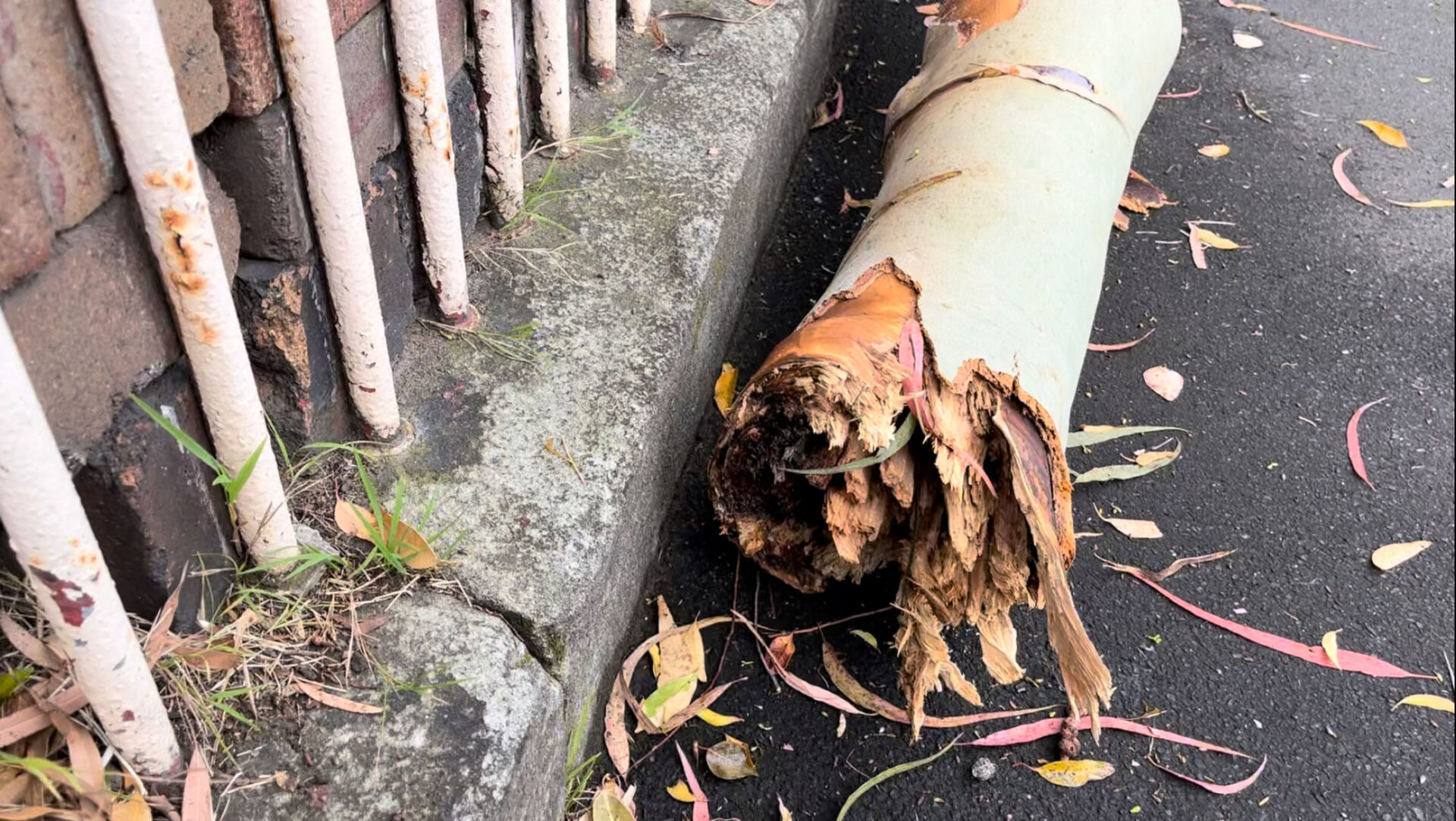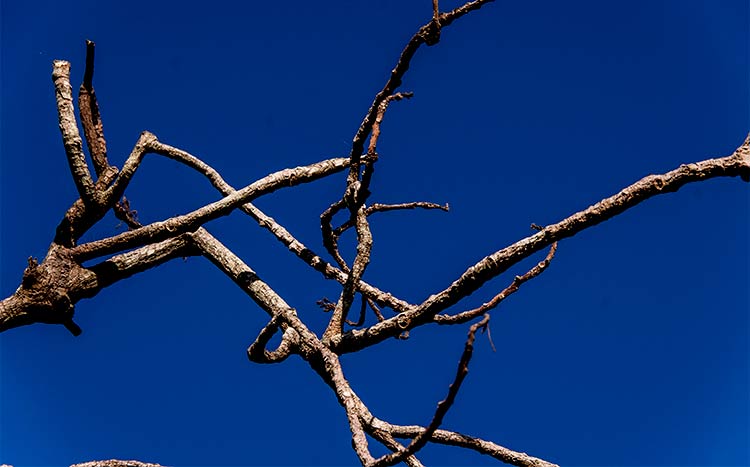Summer branch drop or sudden limb drop is a phenomenon that still baffles experts to a large extent. It’s the event of a tree shredding a healthy branch with no prior warning normally during the summer months.
Normally a tree branch will break off when it is dead, or during heavy winds or some external pressure. Summer branch drop seems to defy logic.
The following is what we know so far.

Table of contents
ToggleWhat Is Summer Branch Drop?
Summer branch drop is a common problem affecting both medium and large trees in the hot summer months. It refers to the tendency of medium or large healthy trees to lose their limbs or branches without warning. The branches or limbs usually break with a cracking sound, split, or fall off.
Summer branch drop may also be referred to as sudden branch drop, sudden branch failure, or summer limb drop. It is a problem that affects most trees and is not restricted to Australia.
Any tree is susceptible to summer branch drop syndrome although some species like oaks seem to have it more often than other species. Summer branch drop is a serious problem that all tree owners in Australia, especially those who experience above-average summer heat like NSW need to worry about.
Possible Causes of Summer Branch Drop
No one thing can be pointed at as the cause or reason behind sudden branch drop. A combination of factors that include weather conditions, condition of the tree, type, and structure of the tree crown, and other unknowns may be the cause of summer branch drop as discussed below.
Weather Conditions- Summer Heat.
Excess summer heat can cause wilting and or drying of branches. With limited evapotranspiration, and as water percentage within the tree’s cells drops, this causes the branches to weaken and fall off without warning. Large heavy branches are normally the first to go.
The biggest cause as most arborists believe is in the hot summer months. Trees always need to release excess moisture through the leaves when conditions allow just like humans need to sweat through the skin.
However, humidity and heat in summer can limit evapotranspiration thus causing the tree to retain moisture. This causes rotting, weakening, and disintegration of branch tissues leading to collapse.
Self-Preservation
It is normal for trees to gradually die when they reach the end of their life expectancy. It is thought that they reactively shed some limbs as they run out of resources in a bid to consolidate and preserve water by reducing consumption and evaporation through leaves.
Most trees do this in summer and may give little warning that they are about to drop their branches.
Weak Junctions (Included Bark and Rotting)
Sometimes branches can have weakened junctions that go unnoticed. A Weak connection at the intersection of any branch to the stem or another branch means the branch can break off easily. Branch or limb junctions can be weakened by bark inclusions, pest infestations, or physical stress.
Only trained arborists can test and detect weak branch junctions or included bark on a tree’s crown. Some trees may have severe bark inclusions yet appear healthy until the branches fall off or get blown away by the wind becoming dangerous projectiles. To prevent this, have your trees checked every year.
Unbalanced Tree Crown
You may find it strange or weird to think that a tree can develop an oversize or overweight crown leading to problems with balance. Indeed, most large trees (especially shade trees) do develop very dense crowns with large branches that become unbalanced over time. It is important to have your trees trimmed regularly to avoid this.
Due to overcrowding, physical stress, and constant rubbing in the wind, some branches will become structurally weak or develop cracks over time. This is one of the reasons why some will end up falling without warning come summer when intense heat causes drying or softening of bark.
Tree experts often take regular measurements of a tree’s crown density and crown spread to determine how much trimming or pruning they need to do to keep the branches healthy and strong. They can also tell if there are weak or structurally compromised branches in the crown.
Physical Stress/Friction on Branches
It’s also very common for branches or major limbs to fall off or break if there is too much friction between them or from physical stress. Friction can be caused by closely arranged branches or limbs in rough winds weakening the bark and joints over time. Physical stress can occur if the branches intertwine or are resting on each other as they grow and elongate to reach the sun.
This is very common in shade trees with dense canopies. It can be worse if it is a fruiting tree or if you live in a place with gusty winds in the summer. You can see signs of physical stress or friction on tree branches in the summer if there is peeling or dented bark where the branches intersect or meet.
Internal rotting or cracking
It’s also very common for branches to develop internal cracks that will eventually cause the branch to break off especially when swaying in the wind. Internal cracking can be because of diseases, pest infestation, moisture or nutrient levels, gas releases, bacteria affecting wet wood, etc.
As you can guess, internal rotting or cracking on tree limbs and branches is extremely hard to discover or detect from the ground or without the right tools and training. Only trained tree surgeons or arborists can detect such problems and take the necessary steps to prevent the branches from falling or dropping in summer.
Pests, Diseases, And Animal Damage
Trees play host to many pests, insects, birds, and animals such as squirrels. Some of these tenants are non-destructive while others such as termites and bacteria can cause damage to branches and other parts of the tree.
In the case where there is damage caused by external agents like termites, branches will naturally weaken and fall off at any time but more often in summer. At the same time, some diseases may also weaken the internal and external structure of tree branches causing them to break or crack.
Conclusion
I believe that the cause is most likely a combination of a few things. As it only occurs in the summer, I think it is most likely a reactionary effect of the tree to preserve resources, not in an intelligent way, but just through cause and effect.
Less water causes resources to cause cell dehydration and wilting until the weakest branch drops off as it is unable to support its own weight at the branch union to the trunk. Once the branch has shed, the tree has the same amount of water resources and roots to transport them, but fewer branches and leaves to sustain meaning there is more to go around.
That being said, it is not hard to imagine internal decay or pest infestation playing a part in the process as pests are more active in the summer months, and a compromised branch would most likely be the first to drop when put under any kind of pressure.
What Trees Drop Their Branches?
Nearly all trees can be affected by summer branch drop syndrome so long as conditions are that branches will be affected in one way or the other. There is limited knowledge on this phenomenon and most arborists will treat each tree equally when it comes to prevention or regular care.
However, it has been observed over time that the following trees are more likely to lose their branches in the hot, humid Australian summer months:
- Oak Trees
- Sycamore trees
- Ficus
- Eucalyptus trees
- Elm trees
- Ash trees and aging or old trees
You will find most of these trees across Australia either in residential areas or natural forests. Some, like Oak trees, are more susceptible to sudden branch drops.

Why Should I Be Concerned About Summer Branch Drops?
There is every to be concerned about summer branch drops especially if the trees are in your yard, near houses or near pathways. Here are some of the risks associated with summer branch falls based on real-life occurrences and facts from the tree-care community in Australia:
Large Branches can Injure People
Imagine sitting under your favorite shade tree on a hot summer afternoon then you hear a slight pop or crack from above. The next thing to happen in some cases is being hit by a large tree limb or branch and getting serious injuries. This is not something you would ever imagine happening to you at any time but it does happen quite frequently.
Injuries linked to sudden branch drops are very common in Australia, especially for hikers and people who venture into natural forests regularly. Falling branches in residential areas also cause serious injuries to pets and people in their way.
Falling Branches May Cause Damage
If a falling branch falls onto a roof, window, or other structure below it, it might cause damage or destroy the entire structure if it’s big enough or coming from a high point on the tree.
Damage caused by sudden branch drops is usually covered in home insurance covers but it’s a big inconvenience to have to repair your house when you can prevent it. Also, note that you are liable for any damage caused to your neighbor’s property from a tree in your yard. This type of damage may not be covered under house insurance.
Debris from Fallen Branches
Branches dropping from trees can block pathways, pavements or appear unsightly in your well-kept yard or lawn. If the branch or tree limb is large enough, it can even block entire roads or streets causing inconvenience to traffic. It will also cost more to clear such fallen limbs or branches than it could have cost to trim or cable them before they fell.
How Do I Prevent Sudden Branch Drops?
Summer branch drops can be hard to prevent, especially those that occur through natural means because of self-preservation. However, there is a lot that can be done to minimize summer branch drops and keep everyone safe.
Some of the things you can do to prevent or minimize summer branch drops include:
Regular Trimming
Trimming is one of the most effective ways of keeping a tree’s crown healthy and balanced thus preventing summer branch drops. It involves selectively removing healthy branches or tree limbs to manage the crown shape, spread, and density. Trimming will also create ample space between branches and limbs to prevent intertwining or physical stress to branches.
Tip: Trimming large trees is an exercise best left to trained experts. Tree experts are trained to work at height and trim large trees safely. If you need help finding top-rated tree experts near you in Australia, scroll to the top of this page and use our free tool. You only need to enter your zip code; answer a few simple questions and we will help you connect with tree experts near you.
Regular Pruning
Pruning is more effective at preventing sudden branch drops when done at the right time and correctly. Pruning is the removal of dead, rotten, compromised, sick, dry, and pest-infested branches from a tree. By identifying and removing these branches, you will prevent them from falling into people, houses, or roads without warning.
Cabling and Bracing
Cabling and bracing are both more radical but effective ways of preventing sudden branch falls. An expert can identify branches or limbs that are likely to fall off or split in summer and cable or brace them as a preventive measure. The branches will be able to maintain their structure and regain health after some time.
Tree Removal
In the worst case, you may need to have a tree removed if it is likely to drop large branches in summer. For instance, you can opt to remove a tree that has large branches hanging over your roof if it is among those that drop their branches or if it has caused damage before. Be sure to talk to an expert before you remove such trees.
I am text block. Click edit button to change this text. Lorem ipsum dolor sit amet, consectetur adipiscing elit. Ut elit tellus, luctus nec ullamcorper mattis, pulvinar dapibus leo.
FAQ's
Lorem ipsum dolor sit amet, consectetur adipiscing elit. Ut elit tellus, luctus nec ullamcorper mattis, pulvinar dapibus leo.
Lorem ipsum dolor sit amet, consectetur adipiscing elit. Ut elit tellus, luctus nec ullamcorper mattis, pulvinar dapibus leo.






